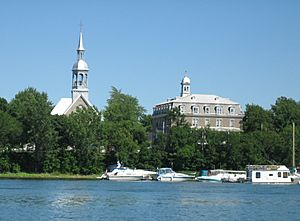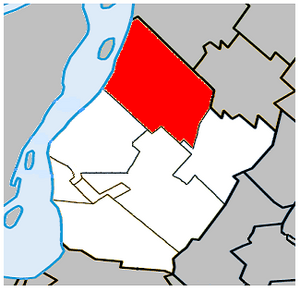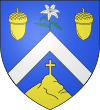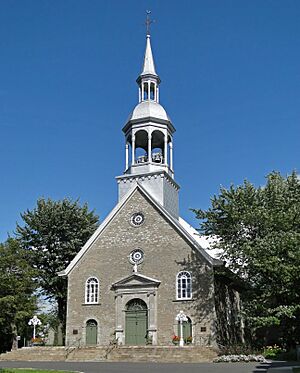Boucherville facts for kids
Quick facts for kids
Boucherville
|
|||
|---|---|---|---|
|
City
|
|||
| Ville de Boucherville | |||
 |
|||
|
|||
| Motto(s):
Nature, patrimoine et art de vivre
(French for "Nature, heritage and the art of life") |
|||

Location within Urban Agglomeration of Longueuil.
|
|||
| Country | Canada | ||
| Province | Quebec | ||
| Region | Montérégie | ||
| RCM | None | ||
| Agglomeration | Longueuil | ||
| Settled | 1667 | ||
| Constituted | January 1, 2006 | ||
| Area | |||
| • Total | 81.10 km2 (31.31 sq mi) | ||
| • Land | 71.02 km2 (27.42 sq mi) | ||
| Population
(2021)
|
|||
| • Total | 41,743 | ||
| • Density | 587.8/km2 (1,522/sq mi) | ||
| • Dwellings | 17,733 | ||
| Time zone | UTC−05:00 (EST) | ||
| • Summer (DST) | UTC−04:00 (EDT) | ||
| Postal code(s) |
J4B
|
||
| Area code(s) | 450 and 579 | ||
| Highways |
|||
Boucherville is a city in the Montérégie region of Quebec, Canada. It's a suburb of Montreal, located on the south side of the Saint Lawrence River. Boucherville is part of the urban agglomeration of Longueuil and the larger Montreal Metropolitan Community.
Contents
History of Boucherville
How Boucherville Started
Boucherville was founded in 1667 by Pierre Boucher. The city is named after him. Pierre Boucher came from France. He first lived in Quebec City and Trois-Rivières. Later, he moved to the Percées Islands near the Saint Lawrence River. This is where he started Boucherville.
The first church in Boucherville was made of wood in 1670. It was replaced by a brick church in 1712. The current Sainte-Famille Church was built in 1801. In the 1700s, some families left Boucherville. They helped start the nearby communities of Sainte-Julie and Saint-Bruno-de-Montarville.
The Great Fire of 1843
In July 1843, a big fire destroyed most of the village. Sparks from a steamboat set a wooden building on fire. The fire quickly spread through Boucherville. The church, a chapel, two schools, 51 homes, and 92 other buildings were burned down.
The village was rebuilt step by step. A new church was built on the same spot over the next two years. A stone school was also built in 1851.
Boucherville Grows and Changes
In 1845, the area around Boucherville became a municipality. This included the village itself. In 1856, the area was split into two separate parts: the parish and the village of Boucherville.
The old system of land ownership, called seigneurial tenure, ended in 1854. Pierre-Amable Boucher de Boucherville was the last person to own land under this system.
By the late 1800s and early 1900s, Boucherville became a popular vacation spot. People from Montreal could visit by train or ferry. The city grew a lot after World War II. This growth was helped by the building of the Louis-Hippolyte Lafontaine Bridge-Tunnel.
Boucherville Today
Boucherville officially became a city in 1957. In 1963, the city of Boucherville merged with the Sainte-Famille de Boucherville parish. This created the city limits we see today.
A new community center opened in 1966. It had pools, offices, and an indoor arena. It was later named after Pierre Laporte. This center was updated and reopened in 2015.
In January 1998, a severe ice storm hit the area. Boucherville lost power. A train engine was even brought to city hall to act as an emergency power generator!
In 2002, Boucherville became part of Longueuil. But after a vote in 2004, it became an independent city again in 2006. It is still part of the urban agglomeration of Longueuil.
Today, Boucherville has over 40,000 people. It also has a large industrial park with many businesses. Pierre Boucher, the founder, is remembered with a museum and a statue.
Geography of Boucherville
Boucherville has several distinct neighborhoods:
- Harmonie: This area is mostly residential with many newer, upscale homes. It has many parks and green spaces. The city's multifunctional center is also located here.
- Quartier des villes et provinces de France: The streets and parks in this neighborhood are named after provinces of France. It mainly has separate or semi-detached houses.
- Old Boucherville: This is the original part of the city. It includes the historic village and the Sainte-Famille Church. Many buildings here are officially protected as historic monuments.
- Industrial Section: This area is in the western part of the city. It has three industrial parks. These parks have grown a lot over the last 20 years. Today, about 600 companies are located here, providing 15,000 jobs. There are also two research centers. The Boisé du Tremblay Wildlife Reserve is also in this section.
- Seigneurie: This is a residential neighborhood built in the early 1960s. It used to have a shopping mall that was a main commercial spot.
- Le domaine Sabrevois: This neighborhood was built in the early 1970s.
- Faubourg Sainte-Anne: This was a neighborhood located at the edge of the old village. It was last mentioned in records in 1875.
People of Boucherville (Demographics)
|
||||||||||||||||||||||||||||||||||||||||||||||||||||||||||||||||||||||||||||||
In 2021, Boucherville had a population of 41,743 people. Most people in Boucherville speak French. About 88% of residents speak French as their first language. About 2.4% speak English as their first language. Other languages spoken include Spanish, Arabic, Italian, and Portuguese.
In 1681, the village had 179 people living in 39 families. They farmed about 320 acres of land. An old report from 1811 shows that the village had doctors, merchants, blacksmiths, bakers, and two schools. There were 91 houses, with 25 of them made of stone.
Economy of Boucherville
Boucherville's industrial park is very important to its economy. It's located near Highway 20. This area has grown a lot since the 1980s. Now, about 575 businesses are located here. They provide jobs for 23,000 people.
Since 1974, the main office of Rona has been in Boucherville. Rona is a big Canadian company that sells hardware, home improvement, and gardening products.
The creators of "Têtes à claques", a popular French internet comedy show, are also based in Boucherville.
Arts and Culture in Boucherville
Internet Culture
The funny internet show Têtes à claques is created in Boucherville.
Youth Centre
In 1973, a youth center called the Maison des Jeunes opened. It moved to the old town hall in 1975. In 2001, the center, now called Maison des jeunes la Piaule, moved into a new building designed just for them.
Fun Things to Do in Boucherville (Attractions)
The Îles-de-Boucherville National Park is a special place. It's located on the Boucherville Islands in the Saint Lawrence River. These islands are not lived on. They are a natural area for residents and tourists to enjoy outdoor activities.
Sports in Boucherville
Boucherville has two main sports facilities.
Complexe aquatique Laurie-Eve-Cormier
This aquatic center opened in 2017. It replaced the old Centre sportif Pierre-Laporte.
Centre multifonctionnel Francine-Gadbois
This center offers both cultural and sporting activities. It is located on Lionel-Daunais road.
Outdoor Sports
Boucherville has a disc golf course. In 2013, it became the first disc golf course in the Montreal area to be fully funded by the public.
Education in Boucherville
Primary Schools
As of 2015, Boucherville has seven public primary schools that teach in French. There is also one private French primary school. For English speakers, there is one public primary school called Boucherville Elementary School.
Secondary Schools (High Schools)
Boucherville has one high school, the French-language public École secondaire de Mortagne. It was built in 1968. Students at this school started wearing uniforms in 2012. There has never been an English-language high school in Boucherville.
English Language Education
English public education in Boucherville is currently provided by the Riverside School Board.
Sister Cities
Boucherville has special connections with other cities around the world:
- Mortagne-au-Perche, France (since 1966)
- Les Abymes, France (since 1988)
- Kingston, Canada
Famous People from Boucherville

Many notable people have connections to Boucherville, including:
- Pierre Boucher (1622–1717), the founder of Boucherville.
- Louis-Hippolyte Lafontaine (1807–1864), a former leader of the Province of Canada.
- Étienne Desmarteau (1873–1905), a policeman and the first Olympic medalist from Quebec.
- Toussaint Charbonneau (1767-1843), who was part of the famous Lewis and Clark Expedition. He was married to Sacagawea.
- Ginette Reno, a well-known singer and actress.
- Jonathan Duhamel, who won the 2010 World Series of Poker Main Event.
- Michel Beaudet, the creator of the popular internet show Les Têtes à Claques.
- Pierre-Luc Gagnon, a professional vert skateboarder.
- Sebastien Lareau, a professional tennis player.
- Rita Baga, a drag queen and runner-up of Season 1 of Canada's Drag Race.
- Gisèle Lullaby, a drag queen and winner of Season 3 of Canada's Drag Race.
See also
 In Spanish: Boucherville para niños
In Spanish: Boucherville para niños






